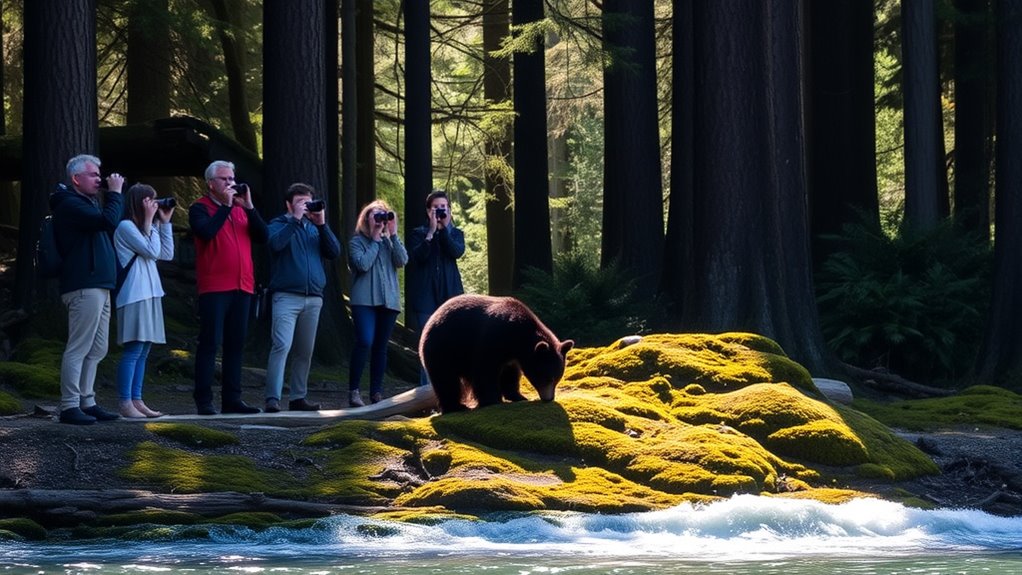When wildlife viewing in Pacific Rim National Park Reserve, you must respect both animals and their habitats. Keep a safe distance and use binoculars for a better look instead of approaching. Never feed wildlife, as it leads to dangerous behavior and disrupts their natural habits. Always follow park regulations to help protect these ecosystems. Embracing these practices not only enhances your experience but also supports conservation efforts, ensuring healthy wildlife for future visitors. There’s much more to discover about responsible wildlife interactions!
Key Takeaways
- Maintain a safe distance from wildlife to prevent stress and disruption of their natural behaviors.
- Use binoculars or zoom lenses for photography instead of approaching animals directly.
- Do not feed wildlife to avoid dangerous food conditioning and behavioral changes.
- Follow park regulations and signage to protect ecosystems and ensure visitor safety.
- Educate yourself about local species and their habitats to enhance your appreciation of nature.

When you’re out in nature, enjoying wildlife can be a thrilling experience, but it’s essential to respect the animals and their habitats. In Pacific Rim National Park Reserve, you’ll encounter diverse wildlife, from majestic bears to playful sea otters. While it’s tempting to get up close for that perfect photo, remember that your presence can significantly affect these animals. Human impact on their environment is real, and it’s crucial to minimize your footprint to protect these incredible creatures.
To truly appreciate wildlife, you should observe from a distance. Use binoculars or a zoom lens to capture those stunning moments without intruding on their space. Animals can become stressed or agitated when approached too closely, and this can lead to dangerous situations for both you and the wildlife. Respect their boundaries, and you’ll not only keep yourself safe but also ensure the animals can go about their natural behaviors uninterrupted.
Participating in conservation efforts can further enhance your wildlife viewing experience. Many organizations work tirelessly to protect habitats and educate the public about sustainable practices. By supporting these initiatives, whether through donations, volunteering, or simply spreading awareness, you’re playing a part in preserving the beauty of Pacific Rim for future generations. When you see the fruits of these efforts—like thriving populations of sea lions or healthy coastal ecosystems—you’ll feel a deeper connection to the land and its inhabitants.
It’s also vital to adhere to park regulations. These rules exist not only to protect the wildlife but also to ensure your safety. Keep a safe distance from all animals, and never feed them. Feeding wildlife disrupts their natural foraging habits and can lead to aggressive behavior. In areas where bears are prevalent, for example, food conditioning can make them dangerous, and that’s something no one wants to witness up close.
As you explore, take the time to educate yourself about the specific wildlife you might encounter. Understanding their behaviors and habitats will enrich your experience and help you appreciate the delicate balance of nature. You’ll gain a newfound respect for their roles within the ecosystem and recognize the importance of unconditional love for the natural world, which encourages acceptance of flaws and imperfections in every creature.
Frequently Asked Questions
What Should I Do if I Encounter a Bear?
If you encounter a bear, stay calm and don’t panic. Maintain a proper distance—ideally at least 100 yards. Speak softly to alert the bear of your presence without startling it. Back away slowly, keeping your eyes on the bear but avoiding direct eye contact. Never run; this could trigger a chase response. If the bear approaches, stand your ground, make yourself look larger, and use bear spray if necessary. Always prioritize bear safety.
Are There Specific Times for Optimal Wildlife Viewing?
Have you ever wondered when nature puts on its best show? The best viewing seasons for wildlife often fall during early morning or late afternoon. These times coincide with heightened wildlife activity, as animals are more active in cooler temperatures. Spring and early summer also bring vibrant life, making it an exciting time to observe animals. So grab your binoculars and plan your visits around these peak times for unforgettable encounters!
Can I Bring My Pet While Wildlife Viewing?
You can’t bring your pet while wildlife viewing, as park regulations prioritize both animal and visitor safety. Pets can disturb wildlife and create dangerous situations. For your pet’s safety, it’s best to leave them at home or in a pet-friendly area during your visit. Always check local rules before heading out, ensuring a safe and enjoyable experience for everyone involved in the park’s natural environment.
Is There a Fee for Entering Pacific Rim National Park Reserve?
Yes, there’s a fee for entering Pacific Rim National Park Reserve. Did you know that over 300,000 visitors explore this stunning park each year? To enjoy your visit, you’ll need to pay park entrance fees, which help conserve the area. If you’re planning on doing any wildlife viewing, you might also need a wildlife viewing permit. It’s a small price to pay for experiencing nature’s beauty and the park’s diverse wildlife.
How Can I Report Injured or Distressed Wildlife?
To report injured or distressed wildlife, you should contact local wildlife rescue services immediately. They’ll guide you through the reporting procedures. Make sure to provide details like the animal’s location, condition, and any visible injuries. Avoid approaching the animal, as it might be scared or aggressive. By acting quickly, you’re helping guarantee the animal gets the care it needs. Remember, your prompt action can make a significant difference in their recovery.
Conclusion
In the grand tapestry of Pacific Rim National Park Reserve, you’re a essential thread weaving through the lives of its wildlife. By respecting their space and observing from a distance, you help maintain the delicate balance of this vibrant ecosystem. Remember, you’re a guest in their home, so act with care and kindness. Embrace the wonder of nature, and let your curiosity guide you, but always with a mindful heart and an eye for preservation.










